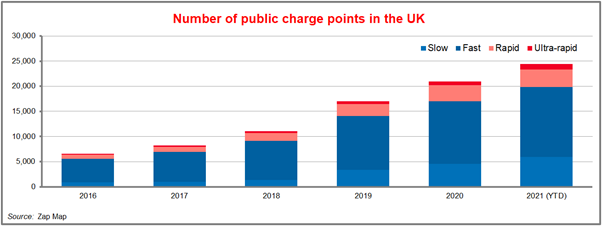Electric cars need charging. And that means we will all need more charge points as the electric revolution takes hold over the next decade. The good news is that, over recent years, we’ve been getting precisely that – more charge points. The better news is that this growth is set to accelerate in the years ahead – and the charge points themselves are going to become faster.
But let’s start in the present. As of September 2021, the UK’s public charging network currently consists of about 26,000 devices, with a total of over 41,000 connectors in over 16,000 locations. This represents a 270% increase over the past five years.
What’s more, over 4,500 of today’s public charge points are either rapid or ultra-rapid chargers, able to bring a car to four-fifths charge in 25 to 40 minutes – or quicker. That’s 365% growth over the past five years.

And that's just the public charging network: there are an increasing number of charge points being installed in supermarket carparks and motorway service stations, many of which can be easily accessed through either contactless cards or apps, and paid for either by subscription or pay-as-you-go. But, of course, there is also an ever growing private charging network: the charge points that workplaces are installing for their employees, and that individuals are installing at home.
This private charging network has been the focus of much Government legislation. There are now a number of grants and other measures available to help reduce the costs, including:
- The Electric Vehicle Homecharge Scheme (EVHS). This offsets 75% of the cost of installing a charge point at home, up to a maximum of £350 (including VAT).
- The Workplace Charging Scheme (WCS). Offers vouchers worth £350 for each of the first 40 charge points installed by an employer.
- 100% First-Year Allowance (FYA). This applies for businesses installing charge points, and is currently scheduled to continue until 2023.
Of course, the suitability of these grants will differ according to your drivers’ or your organisation’s situation, particularly when it comes to home charging. The EVHS, for example, is tremendously easy to apply for – in fact, the application is processed on the driver’s behalf by the charge point installer – but it does require the customer to have "dedicated off-street parking at their property".
Another consideration is whether you would prefer installed chargers to be "tethered" (i.e. with a cable permanently attached) or "untethered" (i.e. with the cable kept separately, most likely in the boot of the driver’s vehicle). The advantages of a tethered charger are convenience and speed. The advantage of going untethered is that you can swap the cable between the "Type 1" and "Type 2" varieties, each with different connectors, that are present in the marketplace – although it should be said that the vast majority of electric cars now use Type 2 connections.
Thought should also be given to the power output of any chargers. Including the rapid and ultra-rapid chargers we have already mentioned, there are effectively four categories of power output, affecting the speed of charging:
- Standard/slow. Up to 3 kilowatts (kW) of AC charge. These take around 6 to 12 hours to fully charge a Battery Electric Vehicle (BEV), or about 2 to 4 hours for a Plug-in Hybrid Electric Vehicle (PHEV).
- Fast. Between 7kW and 22kW (AC). They can fully charge a BEV in around 3 to 4 hours.
- Rapid. Between 25kW and 99kW (DC). These can fully charge a BEV in about 1 to 1.5 hours.
- Ultra-rapid. 100kW and over (DC). Generally, these can fully charge compatible BEVs in less than an hour.
Different homes can accommodate different power outputs, depending on their own electrical systems. That said, most domestic chargers now tend to sit around the 7kW or 11kW range – i.e. fast. The more powerful fast charge points are more prevalent in workplaces and car parks. And rapid and ultra-rapid models are most common in motorway service stations.
All these options mean two things for fleets and their drivers: choice and coverage. Even someone who doesn’t have any parking space near their home should be able to choose an alternative way of charging their electric vehicle – whether that’s through the public charging network or, even more convenient, at their workplace. And that’s increasingly true for most parts of the country.
The coverage isn’t perfect, of course. Looking at the Zap Map of public charge points around the UK, there are noticeable gaps – particularly (and understandably) in the Scottish highlands. Electric motoring in these areas should be done with greater consideration of routes and potential charging stops. They might also be better suited to vehicles with higher driving ranges, or even PHEVs that have the fallback option of a petrol engine.
Even so, it ought to be noted that the driving ranges of many EVs are now more than sufficient for most journeys. A real-world range of 150 to 200 miles is now pretty standard, while some new models of electric vehicle, such as the Tesla Model 3 Long-Range, can go up to or even beyond 300 miles. The highlands might not be unconquerable, particularly if you have somewhere to charge your vehicle overnight.
Besides, the Government is provisioning for more public charge points. The "Green Industrial Revolution" plan announced by Boris Johnson at the end of last year earmarked £1.3 billion to "accelerate the roll out of charging infrastructure," with a particular emphasis on both rapid charge points alongside major roads and on-street charge points near homes and workplaces. This comes on top of previous investment designed to make good on one of the pledges in the 2019 Conservative manifesto: "to ensure that everyone is within 30 miles of a rapid electric vehicle charging station."
And, all the while, the technology of charging is likely to improve – bringing down the length of time that it will take to refuel your vehicle’s battery. Indeed, the same governmental green plan also sets a "target milestone" of 2030 for when "we expect the network of charge points… to be more extensive with than 2,500 high powered charge points that can charge your car so it can drive over 100 miles, all in the time it takes to have a cup of coffee".
That milestone year of 2030 is also, of course, when the sale of new petrol and diesel vehicles ends. That’s why a comprehensive network of efficient charge points is so important – it’s likely that we’re all going electric.
About the contributor

Tash Turner
Fleet Consultant
Specialisms: Financial modelling, Total Cost of Ownership, Fleet Optimisation and Mobility
Tash has over 12 years’ industry experience, including previous roles in Strategic Account Management at KINTO UK and Venson Automotive, working with a variety of private, public and not for profit businesses with both car and van fleets varying from 50 – 5,000 vehicles.
Tash joined ALD in 2021, bringing a wealth of experience and proven ability in working in partnership with customers to identify cost-saving opportunities, share best practice and advise on future strategic fleet decisions. She has considerable experience working with businesses to identify the most suitable funding methodologies as well as enabling and supporting the creation of robust, adaptable and suitable fleet polices, including integration of alternative fuels and Total Cost of Ownership (TCO).
Email: tash.turner@aldautomotive.com
Contact us
Email: roadtozero@aldautomotive.com
Visit: www.aldautomotive.co.uk